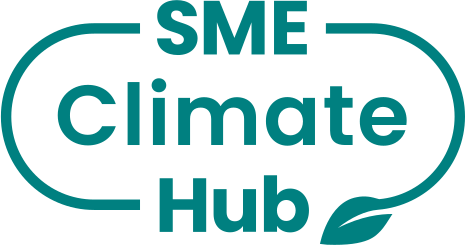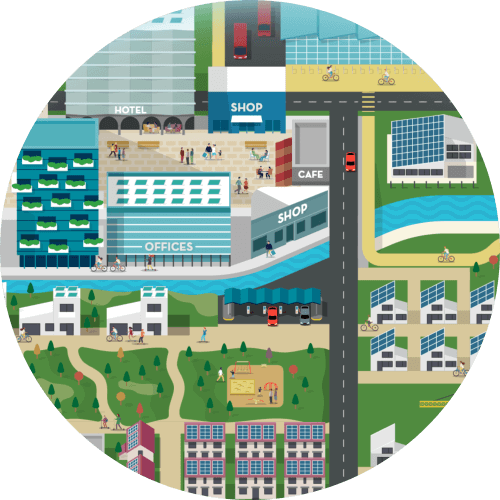Se de steg ditt företag kan ta mot en mer hållbar framtid genom våra öppna resurser.
Perigon Partners LTD's Climate Report
Introduction *
Commitment And Targets *
Own emissions *
Value chain emissions *
(optional)Actions and plans to reduce emissions *
Climate Solutions *
(optional)Management and strategy *
(optional)Results, challenges and outlook *
Introduction *
reporting year
*2023
number of employees in the reporting year
*3
Commitment And Targets *
net zero target year
*2050
Base year
*2022
comment on your net zero targets
*Our target is to reduce Scope 1 and 2 emissions by 90% and scope 3 emissions intensity by 97% and to neutralise remaining emissions.
near-term scope 1 target
*51.6
target year
*2030
near-term scope 2 target
*51.6
target year
*2030
near-term scope 3 target
*51.6
target year
*2030
comment on your near-term targets
*Our near-term target is to reduce total emissions intensity (scopes 1, 2 and 3) by at least 50% and to continue sourcing 100% renewable electricity.
Own emissions *
scope 1 emissions
scope 1 emissions (metric tons co2e)
*1.83
own facilities
*1.83
metric tons CO2eown vehicles
*N/A
own processes
*N/A
scope 2 emissions
scope 2 emissions (metric tons co2e)
*0.0
total energy consumption (kwh)
*787
renewable energy
*100
purchased electricity
*0.0
metric tons CO2eRenewable electricity (%)
100
purchased steam
*N/A
Renewable electricity (%)
-
purchased heating
*N/A
Renewable electricity (%)
-
purchased cooling
*N/A
Renewable electricity (%)
-
Comment on your energy consumption
*We purchase 100% renewable electricity. On a location-basis, our emissions from purchased electricity are 0.16.
Value chain emissions (optional) *
scope 3 emissions
scope 3 emissions (metric tons co2e)
*8.98
supply chain related - upstream emissions
purchased goods and services
*6.74
metric tons CO2ecapital goods
*0.45
metric tons CO2efuel and energy related activities
*0.38
metric tons CO2etransportation and distribution (upstream)
*N/A
waste in operations
*N/A
business travel
*1.05
metric tons CO2eemployee commuting
*0.36
metric tons CO2eleased assets (upstream)
*N/A
customer related - downstream emissions
transportation and distribution (downstream)
*N/A
processing of sold products
*N/A
use of sold products
*N/A
end-of-life treatment of products
*N/A
leased assets (downstream)
*N/A
franchises
*N/A
investments
*N/A
List any sources of emissions excluded:
*Only categories of emissions that have been excluded have been assessed to be not relevant to Perigon's business model or highly immaterial.
describe the calculation methodology and comment on accuracy:
*All emissions conversion factors are taken from the Department for Energy Security and Net Zero's GHG conversion factors for company reporting database for 2023. Emissions from purchased goods and services are based on supplier-specific data and, where this is not practical to acquire, spend-based estimates are applied using the SME Climate Hub's carbon calculator. Emissions from capital goods are calculated based on publicly-available product-level data. Fuel and energy related activities include the well-to-tank emissions from fuel reported under Scope 1. Business travel, which includes travel-related well-to-tank emissions, is calculated based on activity data. Employee commuting is all related to employee home-working emissions (Perigon operates a virtual team). These emissions are estimated using the UK Government's home working methodology and conversion factors.
Actions and plans to reduce emissions *
Scope 1 Actions
own facilities
Yes
These emissions relate to oil used in heating Perigon's office space within the Founders' rented home. This means they have limited influence over the choice of heating and timeline for decarbonising the heat supply. The plan in the medium term is to move home and office locations to an owned property with the ability for the Founders to install a greener heat source, or to start working more from a separate office location - the choice of which would depend upon it having green heating.
own vehicles
N/A
-
own processes
N/A
-
scope 2 actions
purchased electricity
Yes
We will continue to procure 100% renewable electricity. In January 2024, Perigon purchased its first company EV which will result in a reduction in business travel scope 3 emissions in 2024 but an increase in purchased electricity. Every effort will be made to reduce the amount of charging using non-renewable electricity.
purchased steam
N/A
-
purchased heating
N/A
-
purchased cooling
N/A
-
scope 3 actions
supply chain related (upstream)
purchased good and services
*Yes
We will increasingly look to obtain actual emissions data from suppliers so that we can better understand the actions we can take to reduce the intensity of emissions as we grow the business.
capital goods
*Yes
We have a policy in place to buy second hand capital goods (e.g. laptops) where possible. We expect these emissions to spike in 2024 due to the company's purchase of an EV, but fall back thereafter to normal levels.
fuel and energy related activities
*Yes
Plans to reduce these emissions are entirely linked to plans to reduce scope 1 emissions over the medium term.
transportation and distribution (upstream)
*N/A
-
waste in operation
*N/A
-
business travel
*Yes
The company purchased an EV in January 2024 which will reduce business mileage-related emissions. We will continue to conduct the majority of our operations remotely, using video technology and Microsoft 365 to collaborate, and choose lower-carbon transport options wherever possible. For example, 100% of the Founders' travel to London was via rail rather than air.
employee commuting
*Yes
As we grow the team, our employee home-working emissions will inevitably rise. We already share guidance on how employees can reduce their home-working emissions and will continue to make sure that this is a regular feature in team meetings.
upstream leased assets
*N/A
-
customer related (downstream)
transportation and distribution (downstream)
*N/A
-
processing of sold products
*N/A
-
use of sold products
*N/A
-
end-of-life treatment of products
*N/A
-
leased assets (downstream)
*N/A
-
franchises
*N/A
-
investments
*N/A
-
i have asked my suppliers to halve emissions before 2030 and join the un-backed race to zero campaign
*No
i have communicated my commitment and actions to my business customers and asked them to join the un race to zero
*No
Climate Solutions (optional) *
are you investing in climate and/or nature outside your value chain?
*Yes
provide details of the project/s you invest in:
*We partner with carbon technology company, CSX Carbon, to purchase high-quality carbon credits and mitigate our GHG emissions beyond our value chain. We are invested in a mixed woodland afforestation project in County Durham, which was planted in 2012.
how are they quality secured?
*Focused on reforming outdated carbon verification mechanisms, CSX carbon uses drones to take high-resolution photos, then feed that imagery into a sophisticated machine learning and analysis tools to produce much more precise picture of carbon sequestration.
which value do they represent (in usd)?
*Perigon currently owns 13 tonnes of carbon credits priced at £35 (USD c.44) each. Total cost c. $396. 9 tonnes relate to 2022 and 4 to 2023 (scopes 1, 2 and 3 category 3, 6 and 7).
Management and strategy (optional) *
Results, challenges and outlook *

Perigon Partners LTD's Climate Report
Perigon Partners LTD's Climate Report - 2023
Introduction *
reporting year
*2023
number of employees in the reporting year
*3
Commitment And Targets *
net zero target year
*2050
Base year
*2022
comment on your net zero targets
*Our target is to reduce Scope 1 and 2 emissions by 90% and scope 3 emissions intensity by 97% and to neutralise remaining emissions.
near-term scope 1 target
*51.6
target year
*2030
near-term scope 2 target
*51.6
target year
*2030
near-term scope 3 target
*51.6
target year
*2030
comment on your near-term targets
*Our near-term target is to reduce total emissions intensity (scopes 1, 2 and 3) by at least 50% and to continue sourcing 100% renewable electricity.
Own emissions *
scope 1 emissions
scope 1 emissions (metric tons co2e)
*1.83
own facilities
*1.83
metric tons CO2eown vehicles
*N/A
own processes
*N/A
scope 2 emissions
scope 2 emissions (metric tons co2e)
*0.0
total energy consumption (kwh)
*787
renewable energy
*100
purchased electricity
*0.0
metric tons CO2eRenewable electricity (%)
100
purchased steam
*N/A
Renewable electricity (%)
-
purchased heating
*N/A
Renewable electricity (%)
-
purchased cooling
*N/A
Renewable electricity (%)
-
Comment on your energy consumption
*We purchase 100% renewable electricity. On a location-basis, our emissions from purchased electricity are 0.16.
Value chain emissions (optional) *
scope 3 emissions
scope 3 emissions (metric tons co2e)
*8.98
supply chain related - upstream emissions
purchased goods and services
*6.74
metric tons CO2ecapital goods
*0.45
metric tons CO2efuel and energy related activities
*0.38
metric tons CO2etransportation and distribution (upstream)
*N/A
waste in operations
*N/A
business travel
*1.05
metric tons CO2eemployee commuting
*0.36
metric tons CO2eleased assets (upstream)
*N/A
customer related - downstream emissions
transportation and distribution (downstream)
*N/A
processing of sold products
*N/A
use of sold products
*N/A
end-of-life treatment of products
*N/A
leased assets (downstream)
*N/A
franchises
*N/A
investments
*N/A
List any sources of emissions excluded:
*Only categories of emissions that have been excluded have been assessed to be not relevant to Perigon's business model or highly immaterial.
describe the calculation methodology and comment on accuracy:
*All emissions conversion factors are taken from the Department for Energy Security and Net Zero's GHG conversion factors for company reporting database for 2023. Emissions from purchased goods and services are based on supplier-specific data and, where this is not practical to acquire, spend-based estimates are applied using the SME Climate Hub's carbon calculator. Emissions from capital goods are calculated based on publicly-available product-level data. Fuel and energy related activities include the well-to-tank emissions from fuel reported under Scope 1. Business travel, which includes travel-related well-to-tank emissions, is calculated based on activity data. Employee commuting is all related to employee home-working emissions (Perigon operates a virtual team). These emissions are estimated using the UK Government's home working methodology and conversion factors.
Actions and plans to reduce emissions *
Scope 1 Actions
own facilities
Yes
These emissions relate to oil used in heating Perigon's office space within the Founders' rented home. This means they have limited influence over the choice of heating and timeline for decarbonising the heat supply. The plan in the medium term is to move home and office locations to an owned property with the ability for the Founders to install a greener heat source, or to start working more from a separate office location - the choice of which would depend upon it having green heating.
own vehicles
N/A
-
own processes
N/A
-
scope 2 actions
purchased electricity
Yes
We will continue to procure 100% renewable electricity. In January 2024, Perigon purchased its first company EV which will result in a reduction in business travel scope 3 emissions in 2024 but an increase in purchased electricity. Every effort will be made to reduce the amount of charging using non-renewable electricity.
purchased steam
N/A
-
purchased heating
N/A
-
purchased cooling
N/A
-
scope 3 actions
supply chain related (upstream)
purchased good and services
*Yes
We will increasingly look to obtain actual emissions data from suppliers so that we can better understand the actions we can take to reduce the intensity of emissions as we grow the business.
capital goods
*Yes
We have a policy in place to buy second hand capital goods (e.g. laptops) where possible. We expect these emissions to spike in 2024 due to the company's purchase of an EV, but fall back thereafter to normal levels.
fuel and energy related activities
*Yes
Plans to reduce these emissions are entirely linked to plans to reduce scope 1 emissions over the medium term.
transportation and distribution (upstream)
*N/A
-
waste in operation
*N/A
-
business travel
*Yes
The company purchased an EV in January 2024 which will reduce business mileage-related emissions. We will continue to conduct the majority of our operations remotely, using video technology and Microsoft 365 to collaborate, and choose lower-carbon transport options wherever possible. For example, 100% of the Founders' travel to London was via rail rather than air.
employee commuting
*Yes
As we grow the team, our employee home-working emissions will inevitably rise. We already share guidance on how employees can reduce their home-working emissions and will continue to make sure that this is a regular feature in team meetings.
upstream leased assets
*N/A
-
customer related (downstream)
transportation and distribution (downstream)
*N/A
-
processing of sold products
*N/A
-
use of sold products
*N/A
-
end-of-life treatment of products
*N/A
-
leased assets (downstream)
*N/A
-
franchises
*N/A
-
investments
*N/A
-
i have asked my suppliers to halve emissions before 2030 and join the un-backed race to zero campaign
*No
i have communicated my commitment and actions to my business customers and asked them to join the un race to zero
*No
Climate Solutions (optional) *
are you investing in climate and/or nature outside your value chain?
*Yes
provide details of the project/s you invest in:
*We partner with carbon technology company, CSX Carbon, to purchase high-quality carbon credits and mitigate our GHG emissions beyond our value chain. We are invested in a mixed woodland afforestation project in County Durham, which was planted in 2012.
how are they quality secured?
*Focused on reforming outdated carbon verification mechanisms, CSX carbon uses drones to take high-resolution photos, then feed that imagery into a sophisticated machine learning and analysis tools to produce much more precise picture of carbon sequestration.
which value do they represent (in usd)?
*Perigon currently owns 13 tonnes of carbon credits priced at £35 (USD c.44) each. Total cost c. $396. 9 tonnes relate to 2022 and 4 to 2023 (scopes 1, 2 and 3 category 3, 6 and 7).
Management and strategy (optional) *
Results, challenges and outlook *
Not sure how to start?
See the steps you can take and get help building a plan to cut your business emissions today.
¿No estás seguro de por dónde empezar?
Revisa los pasos que puedes dar y obtén ayuda para elaborar un plan para reducir las emisiones de tu empresa hoy mismo.
لست متأكداً كيف تبدأ؟
اطلع على الخطوات التي يمكنك اتخاذها واحصل على المساعدة في وضع خطة لخفض انبعاثات شركتك اليوم.
Vous ne savez pas par où commencer ?
Découvrez les mesures que vous pouvez prendre et obtenez de l’aide pour élaborer un plan pour réduire les émissions de votre entreprise dès aujourd’hui.
Ready to commit to lower emissions?
It’s easy to make the commitment. Just complete a form sharing your intent to reduce your emissions.
You’ll earn public recognition for taking the first step.
¿Listo para comprometerte a reducir tus emisiones?
Es fácil comprometerse. Solo tienes que completar un formulario compartiendo tu intención de reducir tus emisiones.
Ganarás reconocimiento público por tomar este primer paso.
هل أنت مستعد للالتزام بتقليل الانبعاثات؟
الالتزام سهل. ما عليك سوى تعبئة نموذج لمشاركة عزمك على تقليل انبعاثاتك.
سوف تحظى باعتراف عام باتخاذك الخطوة الأولى.
Prêt à vous engager pour réduire les émissions ?
S’engager est simple. Il suffit de remplir un formulaire indiquant votre intention de réduire vos émissions.
Vous gagnerez une reconnaissance publique pour avoir fait le premier pas.
Register now to use our tools
Register now to use our tools

Håll dig uppdaterad!
Anmäl dig till vårt nyhetsbrev för att hålla dig uppdaterad med de senaste klimatutvecklingarna.
Logga in
Don't have an account? Create account to access our tools or make the SME Climate Commitment
Logga in
Don't have an account? Create account to access our tools or make the SME Climate Commitment
Logga in
Don't have an account? Create account to access our tools or make the SME Climate Commitment
Forgot password?
Please enter your email address. You will receive a link to create a new password via email.

 Go back
Go back

